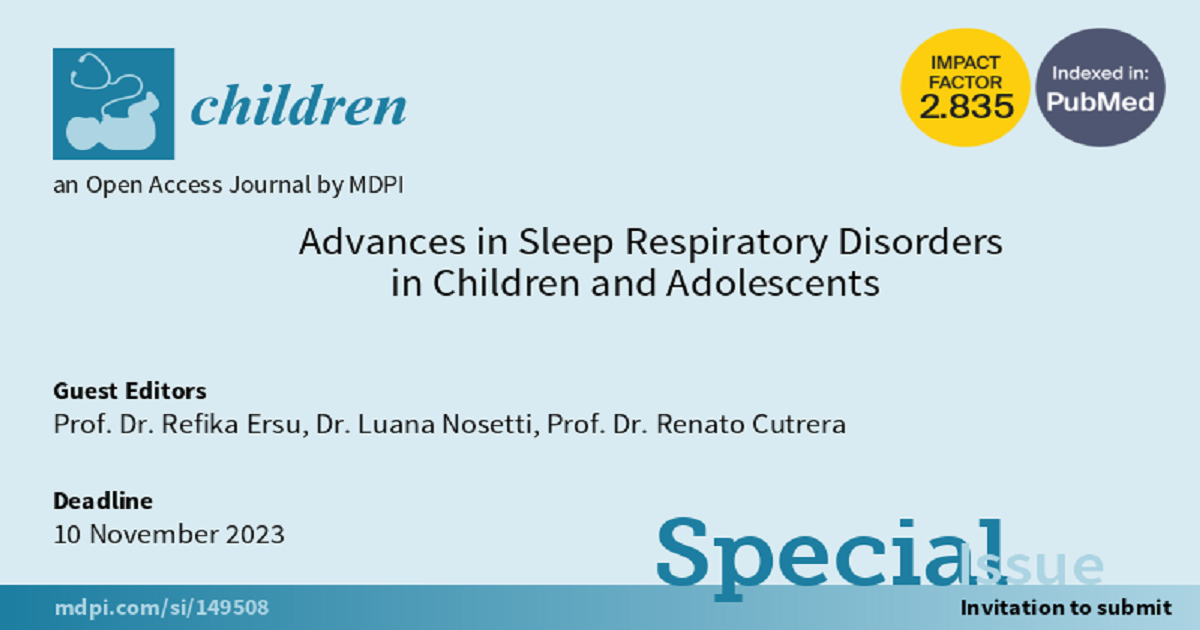- 2.1Impact Factor
- 3.8CiteScore
- 18 daysTime to First Decision
Advances in Sleep Respiratory Disorders in Children and Adolescents
This special issue belongs to the section “Pediatric Pulmonary and Sleep Medicine“.
Special Issue Information
Dear Colleagues,
This Special Issue will focus on sleep disordered breathing (SDB), a spectrum of pathologies of varying degrees of severity which includes habitual snoring, obstructive hypoventilation, upper airway resistance syndrome (UARS) and obstructive sleep apnea (OSA). The latter is common in children, affecting 2–5% of the pediatric population. Untreated OSA is linked to adverse cardiovascular and neurobehavioral outcomes and poor quality of life in children. Additionally, central congenital hypoventilation syndrome (CCHS), apparent life-threatening events (ALTE) and brief resolved unexplained event (BRUE) are part of sleep disorders. The awareness of SDB in children has steadfastly increased over the last several decades.
For this Special Issue, we are seeking original research and review articles focusing on advancements in the epidemiology, complications, diagnostic approaches and management of SDB, with particular attention to multidisciplinary approaches, new therapies and technologies. These papers will stimulate the continuing efforts to improve our understanding in this very interesting field.
The goal of this Special Issue is to serve as a source for pediatric clinical practitioners in the field of SDB for their daily practice, as well as for researchers and their future studies.
Prof. Dr. Refika Ersu
Dr. Luana Nosetti
Prof. Dr. Renato Cutrera
Guest Editors
Manuscript Submission Information
Manuscripts should be submitted online at www.mdpi.com by registering and logging in to this website. Once you are registered, click here to go to the submission form. Manuscripts can be submitted until the deadline. All submissions that pass pre-check are peer-reviewed. Accepted papers will be published continuously in the journal (as soon as accepted) and will be listed together on the special issue website. Research articles, review articles as well as short communications are invited. For planned papers, a title and short abstract (about 250 words) can be sent to the Editorial Office for assessment.
Submitted manuscripts should not have been published previously, nor be under consideration for publication elsewhere (except conference proceedings papers). All manuscripts are thoroughly refereed through a single-blind peer-review process. A guide for authors and other relevant information for submission of manuscripts is available on the Instructions for Authors page. Children is an international peer-reviewed open access monthly journal published by MDPI.
Please visit the Instructions for Authors page before submitting a manuscript. The Article Processing Charge (APC) for publication in this open access journal is 2400 CHF (Swiss Francs). Submitted papers should be well formatted and use good English. Authors may use MDPI's English editing service prior to publication or during author revisions.
Keywords
- obstructive sleep apnea
- sleep disordered breathing
- snoring
- central congenital hypoventilation syndrome (CCHS)
- apparent life-threatening events (ALTE)
- brief resolved unexplained event (BRUE)
- craniofacial malformations
- neuromuscular disease
- obesity
- SDB complications
- SDB co-morbidities

Benefits of Publishing in a Special Issue
- Ease of navigation: Grouping papers by topic helps scholars navigate broad scope journals more efficiently.
- Greater discoverability: Special Issues support the reach and impact of scientific research. Articles in Special Issues are more discoverable and cited more frequently.
- Expansion of research network: Special Issues facilitate connections among authors, fostering scientific collaborations.
- External promotion: Articles in Special Issues are often promoted through the journal's social media, increasing their visibility.
- e-Book format: Special Issues with more than 10 articles can be published as dedicated e-books, ensuring wide and rapid dissemination.

